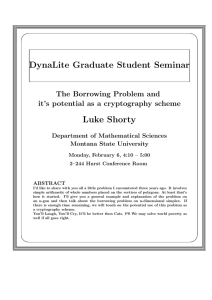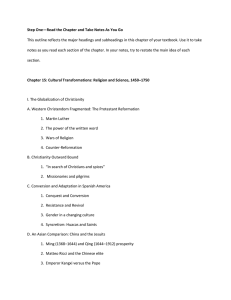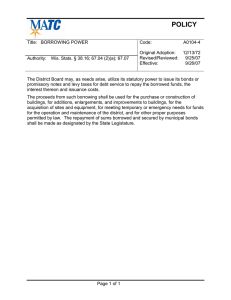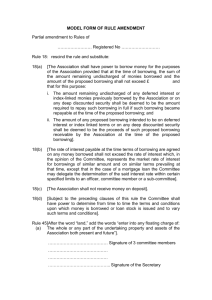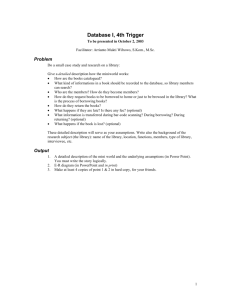LAND USE Annotated Bibliography of K-12 Educational Resources
advertisement
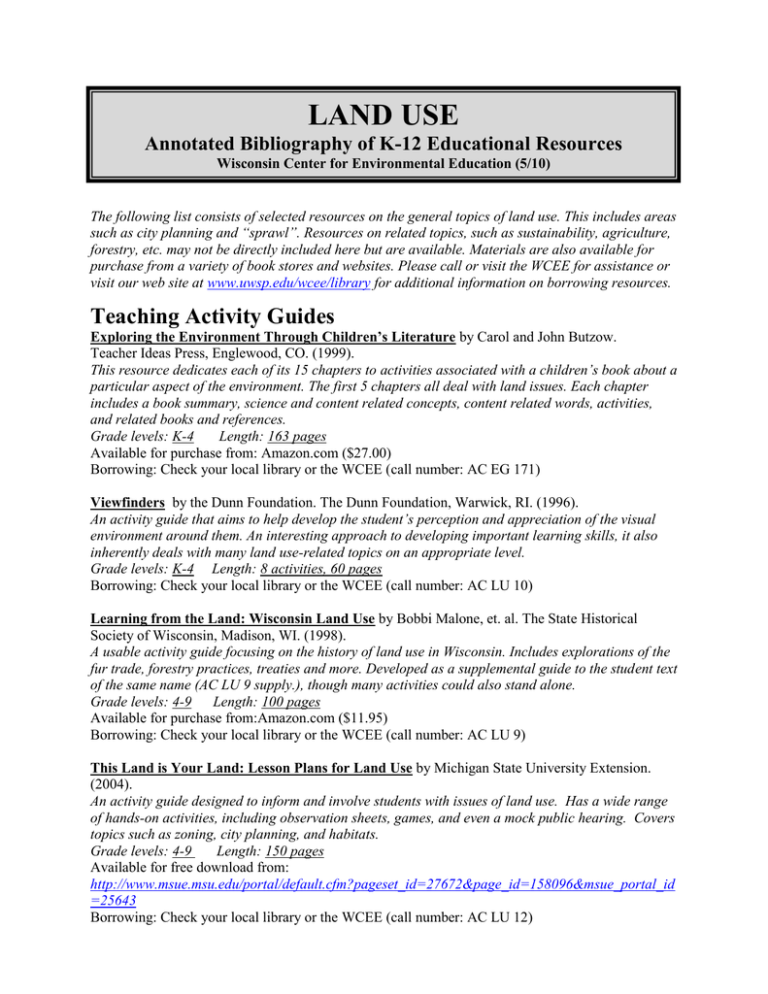
LAND USE Annotated Bibliography of K-12 Educational Resources Wisconsin Center for Environmental Education (5/10) The following list consists of selected resources on the general topics of land use. This includes areas such as city planning and “sprawl”. Resources on related topics, such as sustainability, agriculture, forestry, etc. may not be directly included here but are available. Materials are also available for purchase from a variety of book stores and websites. Please call or visit the WCEE for assistance or visit our web site at www.uwsp.edu/wcee/library for additional information on borrowing resources. Teaching Activity Guides Exploring the Environment Through Children’s Literature by Carol and John Butzow. Teacher Ideas Press, Englewood, CO. (1999). This resource dedicates each of its 15 chapters to activities associated with a children’s book about a particular aspect of the environment. The first 5 chapters all deal with land issues. Each chapter includes a book summary, science and content related concepts, content related words, activities, and related books and references. Grade levels: K-4 Length: 163 pages Available for purchase from: Amazon.com ($27.00) Borrowing: Check your local library or the WCEE (call number: AC EG 171) Viewfinders by the Dunn Foundation. The Dunn Foundation, Warwick, RI. (1996). An activity guide that aims to help develop the student’s perception and appreciation of the visual environment around them. An interesting approach to developing important learning skills, it also inherently deals with many land use-related topics on an appropriate level. Grade levels: K-4 Length: 8 activities, 60 pages Borrowing: Check your local library or the WCEE (call number: AC LU 10) Learning from the Land: Wisconsin Land Use by Bobbi Malone, et. al. The State Historical Society of Wisconsin, Madison, WI. (1998). A usable activity guide focusing on the history of land use in Wisconsin. Includes explorations of the fur trade, forestry practices, treaties and more. Developed as a supplemental guide to the student text of the same name (AC LU 9 supply.), though many activities could also stand alone. Grade levels: 4-9 Length: 100 pages Available for purchase from:Amazon.com ($11.95) Borrowing: Check your local library or the WCEE (call number: AC LU 9) This Land is Your Land: Lesson Plans for Land Use by Michigan State University Extension. (2004). An activity guide designed to inform and involve students with issues of land use. Has a wide range of hands-on activities, including observation sheets, games, and even a mock public hearing. Covers topics such as zoning, city planning, and habitats. Grade levels: 4-9 Length: 150 pages Available for free download from: http://www.msue.msu.edu/portal/default.cfm?pageset_id=27672&page_id=158096&msue_portal_id =25643 Borrowing: Check your local library or the WCEE (call number: AC LU 12) Mapping Our World: GIS Lessons for Educators by Malone, Lyn, A.M. Palmer, & C.L. Voigt. ESRI Press, Redlands, CA. (2002). Complete resource for teachers seeking to bring geographic information system (GIS) into the middle or high school classroom. Contains 19 complete GIS lesson plans, plus a one-year license of Arc-View software and a teacher resource CD. Grade levels: 5-12, adult/university Length: 535 pages Borrowing: Check your local library or the WCEE (call number: AC EG 183) Self & Community - Land Use Planning and the Visual Environment by Joan Chadde, et. al. West Upper Peninsula Center for Science, Mathematics & Environmental Education, Houghton, MI. (1999). Designed for all 14 lessons to be used together as a unit, though clear and logical lesson setup facilitates individual lesson adaptation. Relies on a variety of learning techniques, including worksheets, student readings, games, etc. Grade levels: 5-9 Length: 14 lessons, unpaged Borrowing: Check your local library or the WCEE (call number: AC LU 11) Exploring Environmental Issues: Places We Live by Project Learning Tree. American Forests Foundation / Washington, DC. (2006). This activity guide makes students aware of the forces influencing the growth and development of the communities. The activities put students in charge as they decide how best to use land, how to plan for the future, and how their actions affect the local environment. Grade levels: 9-12 Length: 181 pages Available only through Project Learning Tree workshops: http://www.plt.org/ Borrowing: Check your local library or the WCEE (call number: AC LU 18) Going Places, Making Choices by The National 4-H Council. National 4-H Council, Chevy Chase, MD. (1999). A series of 5 booklets (essentially mini-activity guides) focusing on transportation and mobility issues. The fourth booklet deals specifically with land use, but the other booklets are also quite relevant. Usable formats. Grade levels: 9-12 Length: 17-22 pages each Available for purchase from: http://www.fourhcouncil.edu/enviro_gpmc.aspx ($9.95) Borrowing: Check your local library or the WCEE (call number: AC LS 8) Videos/DVDs Journey to Planet Earth: The Urban Explosion by Screenscope, Inc. (2009). A well-produced (and well-funded) PBS documentary that, through case studies of four major cities, looks at the challenges of sheltering and sustaining the growing human population without destroying the delicate balances in the environment. Many land use issues are directly discussed. Grade levels: 5-12, Adult Length: 57 minutes Borrowing: Check your local library or the WCEE (call number: AV DVD URB 1) Community of Choices by Mauire-Reeder, Ltd. Dunn Foundation, Waruick, RI. (2002). This DVD takes examples of communities in the United States that are making efforts of preserving cultural heritage and open space while still partaking in economic development. They promote sustainable development and smart community planning. Grade levels: 9-12, Adult/University Length: 30 minutes Available for purchase from: http://www.dunnfoundation.org/index.php ($25.00) Borrowing: Check your local library or the WCEE (call number: AV DVD LU 2) Houses in the Fields by The Video Project, Ben Lomond, CA. (1995). An agriculturally-focused exploration of land use issues. Includes a discussion guide for facilitating classroom use. Grade levels: 9-12, Adult Length: 26 minutes Borrowing: Check your local library or the WCEE (call number: AV LU 6) A Convenient Truth by Giovanni Vaz Del Bello, Maria Terezinha Vaz and Del Bello Pictures. (2007). This documentary includes interviews from many influential people in Curitiba, including both mayors, and many social benefits that transformed this city into one of the world's most livable. Grade levels: 9-12, Adult/University Length: 47 minutes Borrowing: Check your local library or the WCEE (call number: AV DVD LU 1) Understanding Urban Sprawl by Films for the Humanities & Sciences, Princetown, NJ. (1999). From “The Nature of Things,” hosted by David Suzuki. A comprehensive look at land use concerns, including the needs and desires of a growing population, societal ideals, problems, successes, and more. Grade levels: 9-12, Adult Length: 47 minutes Borrowing: Check your local library or the WCEE (call number: AV LU 7) Ways We Live: Community by Design by Bullfrog Films, Oley, PA. (1997). Through case studies, looks at the role design plays in communities with different goals. Good also in classroom activities that look at building or discussing “sense of place”. Grade levels: 9-12, Adult Length: 26 minutes Borrowing: Check your local library or the WCEE (call number: AV LU 5) Ways We Live: Maps with Teeth by Bullfrog Films, Oley, PA. (1997). A focused exploration of cartography, but still very relevant to the land use curricula. A great supplement to other land use discussions, allowing for exploration of “sense of place” issues. Grade levels: 9-12, Adult Length: 26 minutes Borrowing: Check your local library or the WCEE (call number: AV LU 4) Books for Youth Adventures of Pelican Pete: First Discoveries by Keiser, Frances et al. Sagaponack Book (2002). This book is a great series; nicely written and illustrated. It's sure to be a hit with young children; pleads for preserving history and the environment. This adventure educates children and their adults about the ancient city and its environments. Grade levels: PK-4 Length: 27 pages Available for purchase from: Amazon.com ($17.00) Borrowing: Check your local library or the WCEE (call number: BY LU 5) Window (1991) and Home (2004) by Jeannie Baker. Greenwillow Books, New York, NY. Fiction. Stunningly visual, wordless books focusing on development issues. Collages depict the view from a boy and girl’s window from birth through marriage—a place that outside looks strikingly similar to the original view before development. Grade levels: PK-4 Length: 28 pages each Available for purchase from: Amazon.com ($5.73 and $14.44) Borrowing: Check your local library or the WCEE (call number: BY LU 1 and BY URB 10) Common Ground: The Water, Earth, and Air We Share by Molly Bang. Blue Sky Press, New York, NY. (1997). Fiction. A story that brings the principles and concepts of Garrett Hardin’s famous paper “The Tragedy of the Commons” to a younger audience. Connects overpopulation to problems with land (and other resource) use. A great resource for initiating class discussions. Wonderful illustrations. Grade levels: K-9 Length: 34 pages Available for purchase from: Amazon.com ($12.47) Borrowing: Check your local library or the WCEE (call number: BY PH 20) The Empty Lot by Dale Fife. Sierra Club Books, San Francisco, CA. (1991). Fiction. A story about a man who discovers that the empty lot he owns within a city is actually quite occupied by a wide range of creatures. Grade levels: K-4 Length: 28 pages Available for purchase from: Amazon.com ($7.95) Borrowing: Check your local library or the WCEE (call number: BY URB 7) Where Once There Was a Wood by Denise Fleming. Henry Holt and Co., New York, NY. (1996). Fiction. A book that, in rhyming prose, looks at all the animal and plant life replaced by urban development. Includes resources about “welcoming wildlife to your backyard habitat”. Great pictures. Grade levels: K-6 Length: 32 pages Available for purchase from: Amazon.com ($7.95) Borrowing: Check your local library or the WCEE (call number: BY EP 8) Reference/Background Books GIS in the Classroom by Marsha Alibrandi. Enslow Publishers, Heineman/Portsmouth, NH. (2003). Written by a teacher, for teachers, this book gives many examples teachers can use to integrate GIS into eh science or social studies classroom. Grade levels: 5-9, 9-12 Length: 175 pages Available for purchase from: Amazon.com ($26.56) Borrowing: Check your local library or the WCEE (call number: BA EG 4) Land Use A-Z by David Newton. Enslow Publishers, Hillside, NJ. (1991). A quick and relatively easy-to-use reference guide covering terminology, legislation, and agencies related to land use. Grade levels: 9-12, adult Length: 126 pages Available for purchase from: Amazon.com ($5.78) Borrowing: Check your local library or the WCEE (call number: BA LU 12) Breaking Gridlock by Jim Motavalli. Sierra Club Books, San Francisco, CA. (2001). Motavalli explores a broad range of potentially valuable transportation improvements in this book, using examples of transportation problems and visions from all over the country and the world, well researched. Grade levels: Adult Length: 268 pages Available for purchase from: Amazon.com ($17.94) Borrowing: Check your local library or the WCEE (call number: BA URB 3) Design Guidelines to Enhance Community Appearance and Protect Natural Resources by Chadde, Joann, L. Rulison, R.A. Smith, J. Dunston. Michigan Technological University, Houghton, MI. (2005). The first half of the guide book discusses growth trends, challenges, and a vision for the future. The second half of the guide book provides design guidelines of the future developments that will enhance comm. Appearance- protect the unique cultural-natural resources of the area. Grade levels: Adult/University Length: 63 pages Borrowing: Check your local library or the WCEE (call number: BA LU 15) From Conquest to Conservation by Dombeck, Micheal et al. Island Press. (2003). This book presents good intentions and concerns for the land. It tells the American story of our relationship with public lands, and the growth of the conservation movement and the resource management field. It also contains focus essay, which will evoke any person to appreciate the public lands. Grade levels: Adult/Uniersity Length: 186 pages Available for purchase from: Amazon.com ($25.00) Borrowing: Check your local library or the WCEE (call number: BA LU 14) Sustainable Cities by EHM, Los Angeles, CA. (1992). A good reference especially for teachers looking to include design elements in their land use curricula. Also includes sections dealing with waste management, transportation, landscaping, etc. Grade levels: Adult Length: 354 pages Borrowing: Check your local library or the WCEE (call number: BA URB 2) Worldwatch Papers 147 and 156 (Series) by Molly O’Meara Sheehan. Worldwatch Institute, Washington, DC. (2001 and 1999). These two papers, entitled “City Limits: Putting the Breaks on Sprawl” and “Reinventing Cities for People and the Planet” are published by the well-respected Worldwatch Institute and serve as helpful primers for many land use issues. Both include many tables and figures. Grade levels: Adult Length: 85 and 94 pages Borrowing: Check your local library or the WCEE (call number: SER WW 147 and 156) Websites Learning Landscapes by the Bureau of Land Management (2010). Usable for kids, teachers, and learners of all ages, this site gives a wealth of information, ideas, games, and activities to do on the 253 million acres of public lands that BLM manages. Grade Levels: 5-12, adult/university Web Link: www.blm.gov/education/index.html Green Map System (2009). Site shows over 600 maps from over 55 countries that are striving for sustainable, green-living communities. Participation is encouraged to make your community a “green map”. Grade Levels: 9-12, adult/university Web Link: www.greenmap.org/ 1,000 Friends of Wisconsin (2010). Designed to keep citizens up-to-date on Wisconsin’s land use planning practices, this site is a good education tool for any educator needing background information on the topic. Grade Levels: adult/university Web Link: www.1000friendsofwisconsin.com Center for Land Use Education (2009). CLUSTER: Creative Land Use Series for Teachers and Educator Resources was designed to help educators include land use topics and issues into existing curriculum. The site offer many educator resources, a conceptual guide with example lessons, and an on-line educator training course. Grade levels: adult/university Web link: http://www.uwsp.edu/cnr/landcenter/cluster/Default.htm Creating My Hometown: An Exercise in Land Use Decision Making by Steve Kohlstedt (2003). This report summarizes an activity that has been used by Steve Kohlstedt for over twenty years to help foster awareness of complex land use issues and conflicts with diverse audiences. Grade Levels: adult/university Web Link: www.uwex.edu/ces/cced/communities/MyHometown_final.pdf ESRI (2010). Providing educators with information about GIS, its applications, and available resources. Also allows you to create and share your own maps. Grade Levels: adult/university Web Link: www.esri.com Land Use Education & Training by the Wisconsin Department of Natural Resources (2008). This site offers K-12 teacher resources, a land use glossary, and links to organizations offering training and technical assistance. Grade Levels: adult/university Web Link: www.dnr.state.wi.us/org/es/science/landuse/education/index.htm#teach Leopold Education Project (2010). LEP offers workshops to educators across the nation to help them learn ways to incorporate Aldo Leopold’s land ethic philosophies into their teaching. Site provides educations with on-line connections to other LEP educators and upcoming conference/workshop details. Grade Levels: adult/university Web Link: www.lep.org/ Sustainable Communities Network (2010). Includes a great deal of downloadable resources and information about creating sustainable communities. Offers ways for you and your students to get involved in your own community. Grade Levels: adult/university Web Link: http://sustainable.org
